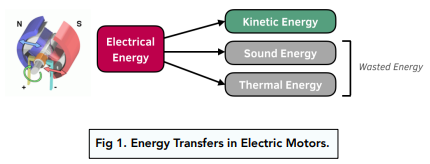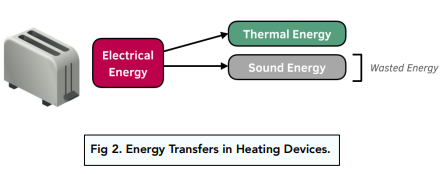Transfers of Energy (GCSE Physics)
Transfers of Energy
Transferring Energy
Everyday Appliances
- Appliances can transfer energy. Everyday electrical appliances in our homes are designed to bring about energy transfers. For example, kettles, microwaves and hairdryers can all convert electrical energy into other forms of energy, which we can then use.
- The amount of energy transfer can vary. Depending on various factors, the energy transferred by an appliance can vary. These are:
- Time – the length of time an appliance is switched on for is very important. The longer an appliance is switched on for, the hotter it will get. As the appliance tries to cool down, it will convert more of the electrical energy input into a thermal energy output. This thermal energy is seen as ‘wasted’ energy, since it is not our desired output. In this way, the longer an appliance it switched on for, the less efficient it becomes.
- Power – different appliances will have different power ratings. A more powerful appliance will use more electricity than a less powerful appliance. However, we still have to be mindful of efficiency. Even if one appliance is more powerful than another, it might have a less efficient energy transfer (i.e. the energy output will have a lot of thermal energy, which is ‘waste’ energy).
Examples of Energy Transfers
- Electric motors use kinetic energy. Electric motors will convert electrical energy from batteries into kinetic energy. This kinetic energy can be used to spin the blades of a fan or move electric cars. The wasted energy here will be mainly in the form of sound and thermal energy.


The Heating Effect of Electric Current
Heating Effect
As an electric current passes through a conductor, some electric energy is converted into heat energy. This causes the conductor to become hot. This effect is called the heating effect of current.
Applications of the Heating Effect of Current
- Filament bulbs – the filament of the bulb is made of tungsten, which has a high melting point. The thin filament also has a very high resistance, so there is a large amount of heat production and the bulb becomes very hot.
- Iron – as current flows through an iron, electric energy is converted into heat energy and conducted through the metal base of the iron. This allows us to compress clothes.
- Electric cooker – the large amount of heat energy produced is conducted by a saucepan, to heat and cook our food.
Disadvantages of the Heating Effect of Current
- Energy loss – energy is dissipated as thermal energy. This reduces the efficiency as heat is lost to the surroundings.
- Fire hazard – if heat is excessively passed through a wire, there could be a risk of a fire which can be very dangerous.
Energy transfer is the process of moving energy from one place to another or from one object to another.
There are three main types of energy transfer: conduction, convection, and radiation.
Conduction is the transfer of energy through direct contact. This means that energy is transferred from one particle to another without any movement of the particles themselves.
Convection is the transfer of energy by the movement of fluids. This can occur in liquids or gases and involves the transfer of energy from the hotter parts of the fluid to the colder parts.
Radiation is the transfer of energy through electromagnetic waves. This can occur through space, such as in the transfer of energy from the sun to the earth, or through materials that are transparent to radiation.
Energy transfers can sometimes be reversed. For example, the transfer of energy from a hot object to a cold object can be reversed by increasing the temperature of the cold object or decreasing the temperature of the hot object.
An example of energy transfer in our daily lives is when we use a toaster to make toast. The electrical energy in the toaster is transferred to thermal energy in the bread, which is then transferred to our mouths when we eat the toast.
It is important to understand energy transfers because they play a major role in many aspects of our daily lives, from cooking food to generating electricity. Understanding energy transfers can help us use energy more efficiently and reduce our impact on the environment.





Still got a question? Leave a comment
Leave a comment